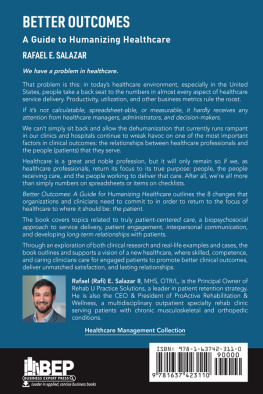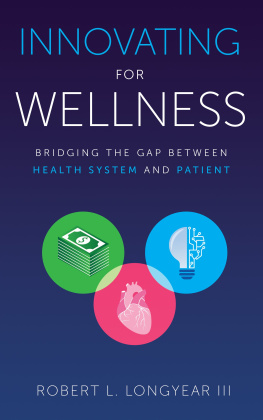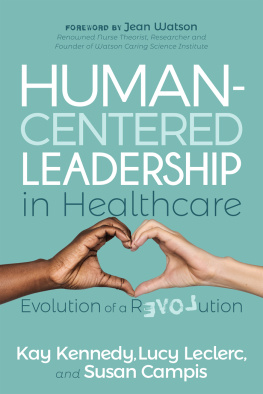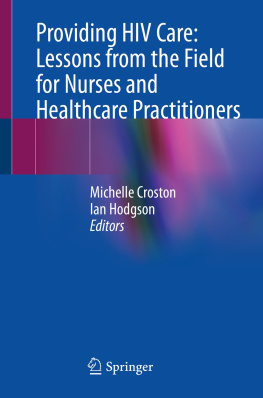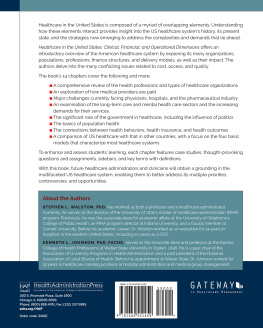Table of Contents
Guide

Better Outcomes
Better Outcomes
A Guide to Humanizing Healthcare
Rafael E. Salazar II, MHS, OTR/L

Better Outcomes: A Guide to Humanizing Healthcare
Copyright Business Expert Press, LLC, 2023.
Cover design by Charlene Kronstedt
Interior design by Exeter Premedia Services Private Ltd., Chennai, India
All rights reserved. No part of this publication may be reproduced, stored in a retrieval system, or transmitted in any form or by any meanselectronic, mechanical, photocopy, recording, or any other except for brief quotations, not to exceed 400 words, without the prior permission of the publisher.
First published in 2022 by
Business Expert Press, LLC
222 East 46th Street, New York, NY 10017
www.businessexpertpress.com
ISBN-13: 978-1-63742-311-0 (paperback)
ISBN-13: 978-1-63742-312-7 (e-book)
Business Expert Press Healthcare Management Collection
First edition: 2022
10 9 8 7 6 5 4 3 2 1
Description
We have a problem in healthcare.
That problem is this: in todays healthcare environment, especially in the United States, people take a back seat to the numbers in almost every aspect of healthcare service delivery. Productivity, utilization, and other business metrics rule the roost.
If its not calculatable, spreadsheet-able, or measurable, it hardly receives anyattention from healthcare managers, administrators, and decision-makers.
We cant simply sit back and allow the dehumanization that currently runs rampant in our clinics and hospitals continue to wreak havoc on one of the most important factors in clinical outcomes: the relationships between healthcare professionals and the people (patients) that they serve.
Healthcare is a great and noble profession, but it will only remain so if we, as healthcare professionals, return its focus to its true purpose: people, the people receiving care, and the people working to deliver that care. After all, were all more than simply numbers on spreadsheets or items on checklists.
Better Outcomes: A Guide for Humanizing Healthcare outlines the 8 changes that organizations and clinicians need to commit to in order to return to the focus of healthcare to where it should be: the patient.
The book covers topics related to truly patient-centered care, a biopsychosocialapproach to service delivery, patient engagement, interpersonal communication, and developing long-term relationships with patients.
Through an exploration of both clinical research and real-life examples and cases, the book outlines and supports a vision of a new healthcare, where skilled, competence, and caring clinicians care for engaged patients to promote better clinical outcomes, deliver unmatched satisfaction, and lasting relationships.
Keywords
healthcare; patient care; healthcare management; healthcare administration; patient centered care; biopsychosocial model; healthcare communication; relationship-based care; value-based healthcare; value-based reimbursement; patient engagement; patient experience; clinical leadership; healthcare reform
Contents
I always hate trying to enumerate and list the countless people who have supported me over the years and helped make this book a reality. I will undoubtedly leave someone off this list, and for that, I apologize.
To start, I would like to acknowledge and thank my wife, Natalie. I once heard someone say that the key to success is to marry well. I, for one, have found this to be true. Natalies love and support over the years has truly made possible the career, impact, and accomplishments I can claim. From the initial decision to leave the secure employment of the VA, she has encouraged me, trusted in me, and motivated me to reach my full potential. For that, I am forever grateful. Id also like to acknowledge my children, Rafa, Joseph, Nathan, Bridget, and Leah. They bring my life so much joy and meaning (as well as the drive to do well, so I can feed them as they grow up!).
Countless colleagues and business associates have helped me clarify my thinking and offered support and encouragement over the course of my career to date.
I want to thank Paul Sterett (https://whitehartinsight.com), for supporting and encouraging me in the early stages of my entrepreneurial journey. From helping me create a website, to discussing business over a drink, I have valued our friendship and am grateful for the encouragement, inspiration, and motivation he has provided over the years.
Another group of folks that deserve mentioning is the wonderful group of professionals I have had the amazing opportunity to work with since I began consulting in the field of disabilities and community integration. First of them is Derrick Dufresne (CRA Consulting). He provided me with the opportunity to step into my entrepreneurial journey by taking a chance and contracting with me to work on the Georgia project. I am forever grateful for the guidance, mentorship, advice, and wisdom he has imparted to me over the years. Bryon Dockter, Laura Paradowski, and Noelle Humphrey took me under their wing as a fledgling consultant, showed me the ropes, and provided guidance and comradery on that first project and on into other ventures. I have been truly blessed to call them not only colleagues, but friends. Lastly, Dan Howell has provided guidance, a listening ear, and advice on our work both on the Georgia project and in new business ventures. All five of these professionals have big hearts, great vision, and I am proud to have been able to work with them over the years to advance care, inclusion, and accessibility for adults with intellectual and developmental disabilities.
I would also like to acknowledge the faculty and staff at the Augusta University Department of Occupational Therapy during my tenure as an assistant professor in the department. They did so much to support me as I began my academic and teaching career. As a newly minted academic and faculty member, they took the time to provide guidance, mentorship, and assistance during my time teaching in the department. This again is another group of professionals with big hearts, great vision, and an unwavering commitment to bettering healthcare practice and service delivery.
I would also like to mention the members on the Board of Directors for the National Board for Certification in Occupational Therapy (NBCOT), as well as the staff at NBCOT I have had the pleasure to work with. As a younger, up-and-coming Occupational Therapy (OT) leader, I have been grateful for the warm welcome, support, and advice I have received during my time on the Board. As an Occupational Therapist, it has truly been a highlight of my OT career to serve alongside them.
One final group that deserves mentioning (like I said, theres a lot of people I have to thank!) is the wonderful team at my private practice, ProActive Rehabilitation and Wellness. The commitment to our patients, the friendly environment, and comradery each of them brings to the team makes going to work each day a blessing and a joy. Working with them over the past couple of years has fueled my passion for patient care, and provided me new insights into the world of healthcare; many of which influenced parts of this book.
Again, this section often ends up being the most difficult to write, because I know I have left some people off this list. If I failed to mention you, please forgive me. As much as our culture might try to convince us, no one is truly self-made. We all rely on our social network, support system, and the work of those who have gone before us. I wouldnt be where I am today without the countless people who helped me, answered my questions, provided opportunities, and even given me critical feedback along the way.

